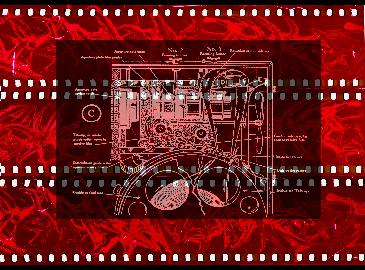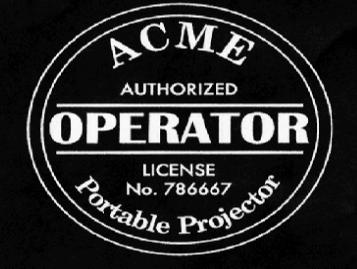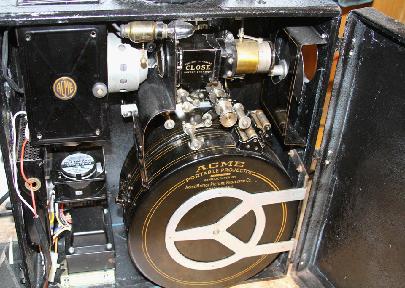 |
|||||||||||
 |
|||||||||||
 |
|||||||||||
 |
|||||||||||
The Hand-Cranked Muse of Cinema (2004) An Expanded Cinema- Projector Performance Piece using an ancient Hand-crank ACME 35mm projector The Muse of Cinema began with a flea market find of a binder of slides. These were made of magic lantern images probably dating from between 1905-1928, and were meant to address directly the movie-going audience in a variety of ways. Some of them referred to problems that were evidently common at the time. It seemed as if wearing hats that obstructed views, spitting on the floor, loud talking, and raucous behavior much annoyed theatre patrons. So the lantern slides were used to keep the audience in line. Some lantern slides would serve to waylay an audience while the projectionist surmounted a technical disaster in the projection booth, while others announced upcoming amateur acts and films to be screened. The lantern slides were reduced to the 35mm format by the Blackhawk Company probably sometime in the 1940’s. Blackhawk and Castle Films released many digest prints on 16mm and 8mm, concerning various topics they would sell to those wanting to put on film shows at home or with their local cinema club. I had these slides for about two years before I finally decided to work with them on 35mm motion picture film by reformatting them on a 35mm slide duplicator. At my place of work (a dental school), I would duplicate slides of intra-oral photography and anatomy slides from instructors’ classes. With free access to this equipment and an amicable, supportive supervisor who allowed me to use the duplicator on the weekend, I was able to reformat the 35mm slide images to the 35mm motion picture format. In 2001, I manage to pick up a large box of 35mm movie film that is intended to be used in an x-ray camera. This film is "orthochromatic,” which means that it is "Red Blind,” or not sensitive to the red spectrum of light. I've been experimenting with this material and contact printing everything in sight from a broken windshield found by the side of the road in my neighborhood to the hairball from the bottom of my bathtub drain. With the help of my dad and his friend, we constructed a registration board to contact print the raw stock with the negative of these images, plus more abstract material that I print Ray-O-Gram style as well as through other means. The "red blind" film is great for using in my living room with only the permanently affixed red Christmas lights on, which run the perimeter of the room. As my apartment is like a cave with no light, it is quite easy to work there. Only one window needs a black cardboard panel to block the white light, and I post signs for my roommate on the outside door of the apartment so that he doesn’t fog the film. I experimented with a variety of lights to expose the film, but most often used a flashlight. Then I acquired a 35mm sync block and contact printer, which enabled me to print faster and with more accuracy, although the registration board works best for multiple strips of film. I hand processed this film material at the San Francisco Art Institute using a hand crank processing tank which allowed me to process up to 100 feet of film at a time. I set up a clothesline from the ceiling that would allow the film to dry, and which created a maze of film images running throughout Studio 8 in the basement of the Art Institute. Finally, I mastered the original film material on a 35mm Oxberry optical printer in Vancouver BC at the film CO-OP Cineworks onto 35mm color negative film stock. This allowed me to highlight key moments of the lantern slides and make them more legible to the audience. Muse of Cinema directly relates to the interaction between the projectionist and the audience. This is the predominant driving force in all my work, but "Muse of Cinema" will vacillate between associative relationships to the group as a whole, and then delve into an internalized realm that directly addresses the individual. Slide shows that precede the narrative feature are still used today but mainly to remind people to not disturb others with cell phones and not to smoke or the slides advertise other films and concessions. The "Muse of Cinema" provides a trajectory to this ongoing audience dialogue. The Muse series calls attention to the operator’s role in bringing these images to the audience. As many experimental filmmakers today, especially Ernie Gehr, Zoe Beloff and Ken Jacobs, directly reference early cinema, and this active relationship of the spectator to projected image, Muse seeks to re-establish and re-affirm the inspirational force of early cinema. As the magic lantern is often considered the grandfather of cinematic technology, magic lantern slides were instrumental in giving filmmakers ways to deal with the temporal aspect of cinema. Lantern slides brought about an understanding of how to use time to allow the story to unfold and reveal a time/concept continuum. The lantern slides that were screened with films had several functions, many slides highlighted upcoming movies and some advertised local retailers in the vicinity of their wares and services. Lantern slides were usually hand painted, and gave viewers a tantalizing single frame peek at the photoplay that would be screened in the near future. Both the magic lanternist and early cinema projectionist were itinerant, going from town to town and performing in the local theater, public hall, university or church. When the projectionist would arrive with hand crank projector in tow, often there would be recommended speeds for the hand crank mechanism. Some projectionists developed reputations from their skill in achieving the desired film speed. While hand-cranking the 1000ft. version of the Muse through the ACME projector, I kept this in mind as I would try to keep in sync with the soundtrack which was on another medium (wild sound). The sound collage was the result of collaboration with Robert Fox, a San Francisco film and video maker and friend who makes exquisite and complex sound/image collage works using both film and digital technologies. Together we have foraged through various libraries using everything was wax cylinder recordings from the first decades of cinema, “Tin Pan Alley” music, calliope music to original recorded sounds. This sound collage enhances the whimsical atmosphere creating a dimensional quality that encompasses the viewer. * Funding was provided by the Princess Grace Foundation Special Projects Grant-2004 and the Museum of Contemporary Cinema-2005. Free access to the Oxberry optical printer was generously provided by Cineworks in Vancouver, BC |
|||||||||||